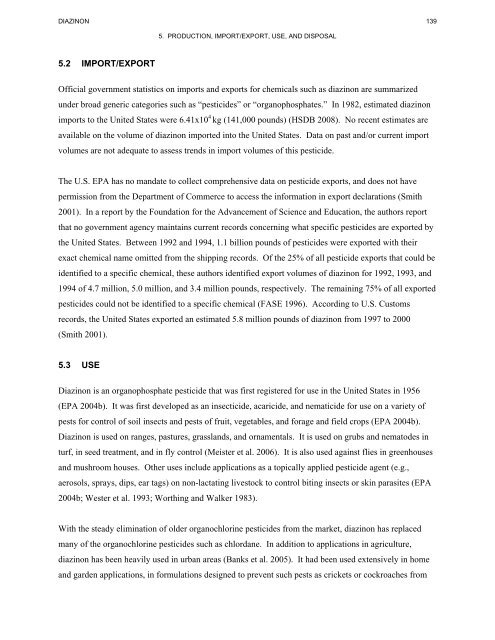Toxicological Profile for Diazinon
Toxicological Profile for Diazinon
Toxicological Profile for Diazinon
You also want an ePaper? Increase the reach of your titles
YUMPU automatically turns print PDFs into web optimized ePapers that Google loves.
DIAZINON 139<br />
5. PRODUCTION, IMPORT/EXPORT, USE, AND DISPOSAL<br />
5.2 IMPORT/EXPORT<br />
Official government statistics on imports and exports <strong>for</strong> chemicals such as diazinon are summarized<br />
under broad generic categories such as “pesticides” or “organophosphates.” In 1982, estimated diazinon<br />
imports to the United States were 6.41x10 4 kg (141,000 pounds) (HSDB 2008). No recent estimates are<br />
available on the volume of diazinon imported into the United States. Data on past and/or current import<br />
volumes are not adequate to assess trends in import volumes of this pesticide.<br />
The U.S. EPA has no mandate to collect comprehensive data on pesticide exports, and does not have<br />
permission from the Department of Commerce to access the in<strong>for</strong>mation in export declarations (Smith<br />
2001). In a report by the Foundation <strong>for</strong> the Advancement of Science and Education, the authors report<br />
that no government agency maintains current records concerning what specific pesticides are exported by<br />
the United States. Between 1992 and 1994, 1.1 billion pounds of pesticides were exported with their<br />
exact chemical name omitted from the shipping records. Of the 25% of all pesticide exports that could be<br />
identified to a specific chemical, these authors identified export volumes of diazinon <strong>for</strong> 1992, 1993, and<br />
1994 of 4.7 million, 5.0 million, and 3.4 million pounds, respectively. The remaining 75% of all exported<br />
pesticides could not be identified to a specific chemical (FASE 1996). According to U.S. Customs<br />
records, the United States exported an estimated 5.8 million pounds of diazinon from 1997 to 2000<br />
(Smith 2001).<br />
5.3 USE<br />
<strong>Diazinon</strong> is an organophosphate pesticide that was first registered <strong>for</strong> use in the United States in 1956<br />
(EPA 2004b). It was first developed as an insecticide, acaricide, and nematicide <strong>for</strong> use on a variety of<br />
pests <strong>for</strong> control of soil insects and pests of fruit, vegetables, and <strong>for</strong>age and field crops (EPA 2004b).<br />
<strong>Diazinon</strong> is used on ranges, pastures, grasslands, and ornamentals. It is used on grubs and nematodes in<br />
turf, in seed treatment, and in fly control (Meister et al. 2006). It is also used against flies in greenhouses<br />
and mushroom houses. Other uses include applications as a topically applied pesticide agent (e.g.,<br />
aerosols, sprays, dips, ear tags) on non-lactating livestock to control biting insects or skin parasites (EPA<br />
2004b; Wester et al. 1993; Worthing and Walker 1983).<br />
With the steady elimination of older organochlorine pesticides from the market, diazinon has replaced<br />
many of the organochlorine pesticides such as chlordane. In addition to applications in agriculture,<br />
diazinon has been heavily used in urban areas (Banks et al. 2005). It had been used extensively in home<br />
and garden applications, in <strong>for</strong>mulations designed to prevent such pests as crickets or cockroaches from
















